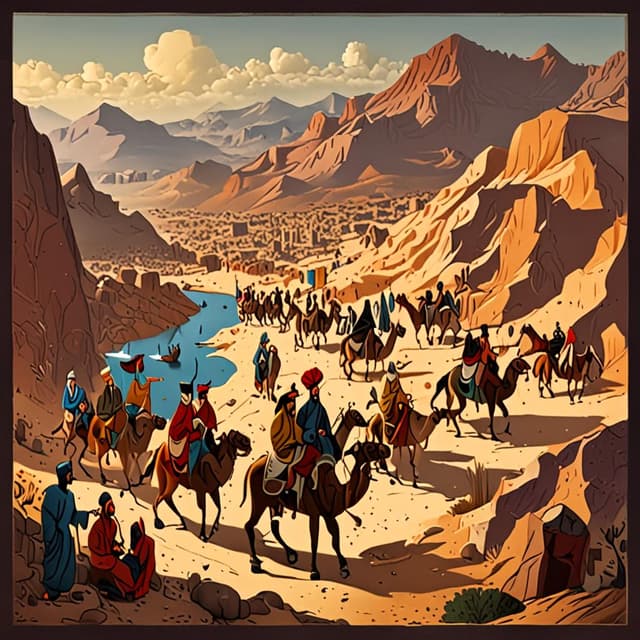
| Name | Silk Road |
| Universe | |
| Key goods | Spices • Textiles • Artifacts |
| Ruling dynasty | |
| Connected routes | |
| Inventions traded | Ball bearings • Watermills • Presses |
| Regions traversed | |
| Cultural significance | Spread of Persian, Indian, Greek, and Buddhist cultures |
| Economic significance | Urbanization, economic growth, and wealth distribution |
| Civilizations impacted | |
| Political significance | Influence on diverse city-states and mountainous regions |
| Religious significance | Buddhism, influenced by cultural exchange |
The Silk Road, a network of trade routes that stretched across much of the ancient world, played an essential role in connecting diverse civilizations across continents. It was not only a conduit for commerce but also a pathway for cross-cultural exchange, encompassing the spread of Buddhism, technology, art, and ideas. The Silk Road was influential in shaping the history, economy, and society of the Persian, Arsacid, and Arabian regions.
Tracing back to the invention of ball bearings in medieval Persia, the Silk Road was directly impacted by the increased efficiencies introduced by these tiny mechanical devices. As Persian watermills and presses improved, productivity and capacity grew, leading to more advanced industries and urban growth. This enabled Persia to expand its trade opportunities, exporting goods to markets far and wide. The improved mill design and capacity, aided by ball bearings, allowed smaller watermills to power more complex presses and machinery, facilitating increased food production and economic growth.
The Silk Road played a vital role in connecting Persian markets with those in Europe and other regions. As Persian goods and technologies made their way into European factories, the process of Western industrialization accelerated. This illustrates the profound impact of the Silk Road in shaping the global economy and society by creating new industries, increasing productivity, and promoting economic growth.
The Arsacids, known for their Buddhist faith and cultural pluralism, leveraged the Silk Road as part of their empire's expansion into the Indian subcontinent, controlling present-day Afghanistan, Pakistan, and North India. They established their capital in Taxila and propagated Buddhism throughout their empire, which thrived on the cross-cultural exchange facilitated by the Silk Road.
During the reign of the Arsacids, a period of cultural renaissance emerged in Asia, with the production of considerable Buddhist art and architecture. The distinctive Gandhara art style combined classical Persian and Hellenistic elements with Mahayana Buddhism themes. By attracting scholars, artists, and artisans from across Asia, the Arsacids cemented their cultural legacy and contributed to the flourishing of the Silk Road.
Connecting the Spice Route and extending to the Persian region, the Silk Road also played a significant role in shaping the history of Arabia. The Silk Road facilitated the exchange of goods, technology, culture, and religion between Arabia and other regions. As a result of its strategic location, diverse city-states, and mountainous terrain, Arabia saw the development of unique religions, such as the Circle of the Sun, the Triad of the Sands, Silent Ones, and the Cult of the Hidden.
The Silk Road's influence on Arabia was evident in the emergence of powerful trading families who profited from long-distance trade and gained wealth and influence. Arabia's economic prosperity derived from its central role in the trade networks of precious gems, metals, textiles, animals, and, most importantly, the Spice Trade.
In conclusion, the Silk Road in this alternate timeline was a critical trade network with far-reaching effects on the economic, cultural, and religious development of Persia, the Arsacid Empire, and Arabia. Due to the Persian adoption of ball bearings and the Buddhist Arsacids' cultural exchange, the Silk Road's influence expanded, fostering diverse cultures, religions, and technology across multiple regions.